How can I build my public image through media relations?
Media relations are about building a relationship with the media in an honest and interactive way so that they will convey your company’s message or point of view.
One way of building public relations is through media relations.
When people read about you in the media, they are more likely to accept the viewpoint as more credible or believable because the message is from an independent source.
The media plays a huge role in affecting people’s attitudes, values and actions. When the media comments favourably on your company, it is seen as an endorsement by a credible third party.
Media exposure helps to create awareness of your organisation, products and brand values. It can position you to enter new markets and put you in a credible light in front of decision makers. To achieve these, you need to build relations with the media that can reach your target audience.
Step by Step Guide to using Media Relations
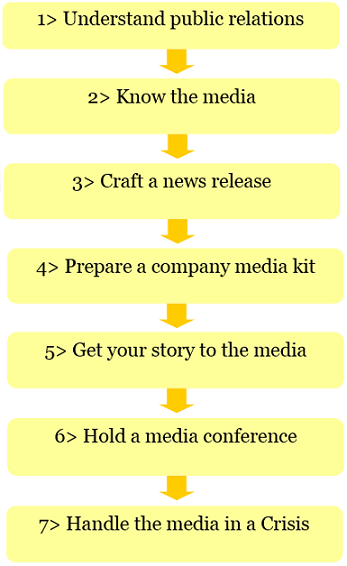
Step 1:
Know the media. You can communicate with your target customers through the voice of the journalist.
A journalist writing a story will only be interested to feature a story that will be of interest to his audience - readers of his newspaper, viewers of his TV programme, or listeners of his radio station.
It is therefore important to ascertain whether the subject of your news release is something that would interest the target audience of that media. Otherwise the journalist would not be interested, no matter how good your story is.
However, you can consider this good news because you can now choose which journalist to work with, and when he is interested in your story, you can be quite confident that it will be read, seen or heard by people who are also interested in it.
The mass media includes print media such newspapers and magazines, broadcast media such as television and radio, electronic or digital media, such as the Internet. The different media may require you to work differently with them.

Act on It
Get in the news
Knowing what types of stories journalist are interested in can determine whether or not your story gets covered. Identify the possible ways in which your company can be in the news, and keep a constant look out for such opportunities.
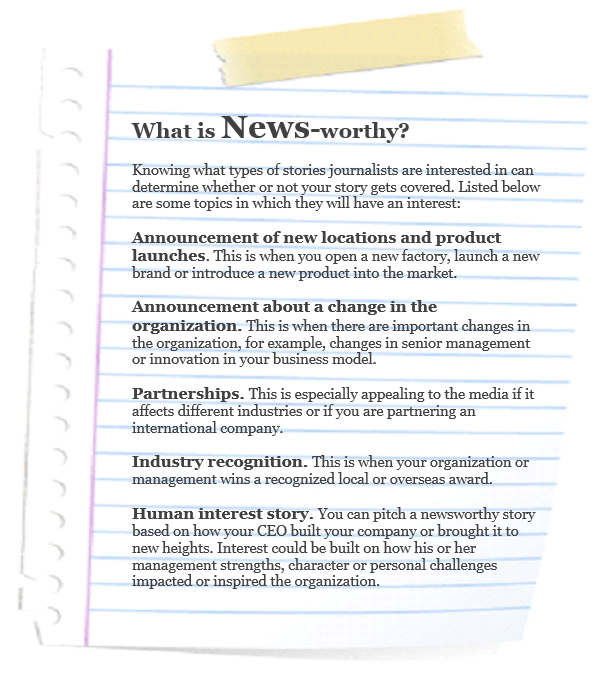
Step 2
Craft a news release. Your news release communicates key information that you want the media to profile.
A news release, sometimes referred to as a press or media release, is a printed or electronic document issued by organisations that want to communicate something newsworthy to editors, journalists, industry writers or other media groups. Journalists will write a story for publication if they consider it newsworthy, while editors control whether the story appears in a newspaper, magazine, website, or broadcast.
A news release can be one of the most important tools in your public relations efforts. It contains important facts, messages, quotes from key people and contact information for additional information. A news release has to be concise and usually runs no longer than two pages.
Tip
The 5Ws & 1H
When you craft your news release, make your story interesting and relevant to the publication and its audience. Use 5Ws 1H, the vital ingredients of all news releases.
What? Usually the hook or attention grabber in your release such as a product launch, new management appointment or an interesting event.
Who? Mention the names of all the people or partners involved.
Where? Name the location that the newsworthy event has taken place or will take place.
When? State the date and time of what has taken place or will take place. The timing of a news release is important. It needs to be just before or after the event in order for it to be considered news.
Why & How? Give a reason or explain the impact of the event to help your audience relate to it and remember it.
Using the Singapore Airlines press release, let's look at the 5W's that are in this article.
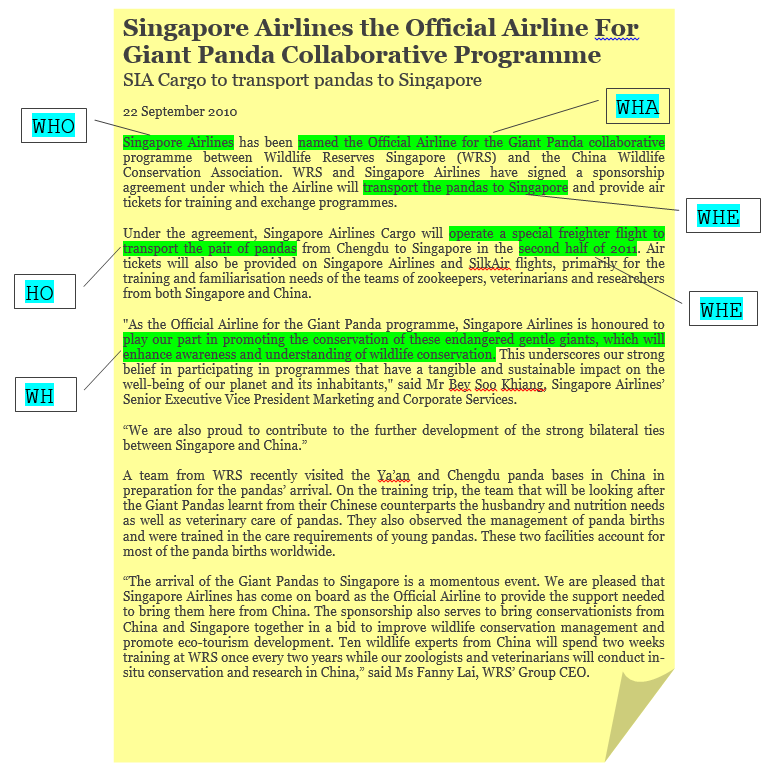
Preparing a news release
Start with the most important information.
Think of it as an Inverted Pyramid.
Remember that each media could receive hundreds of news releases a day, so the header and first paragraph may be the only things that are read before a decision on whether your story is taken is made. A weak header and introduction will result in your news release being bypassed.
1> The Header
Impactful headers are those that skillfully sum up the most significant benefit the reader will derive from this piece of news, ideally within seven words. Remember that it must be important to the reader, not to you. Use eye-catching words such as ‘announces’ and ‘new’ only if it is really true, or you could lose your credibility with that media. Use the header in your email title.
2> The Sub-header
Include a sub-header if it is useful to flesh out your main header, or include a second related news point.
Refer to the following diagram on the structure of your news release.
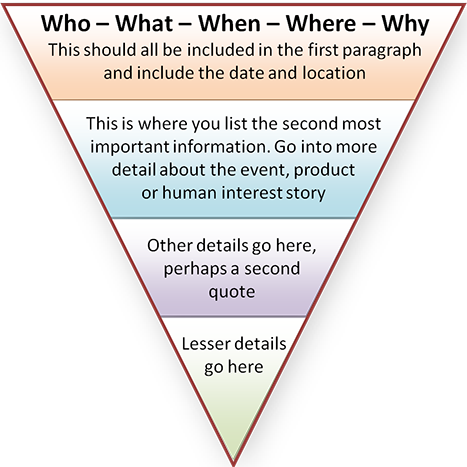
3> The First Paragraph
The first paragraph gives the editor all the information he needs to know to conclude what the whole story is about. Use the 5Ws 1H to capture the vital points about your announcement. You must include all key facts and figures within the first paragraph if possible; use the second if necessary. The information needs to be aligned with what you have put as the header.
4> The Other Paragraphs
The rest of the paragraphs are used to elaborate on the story. You could include insightful quotes from your management, your partners, experts or users, or back up your story with other facts and figures.
Prioritise! Due to limited space in publications and limited time in broadcasting, the bulk of the news release may not be included in the story. Also, the editor may scan through the release quickly and not finish reading everything. Consider what is the most important and put those in first – the sequence tells editors their relative importance.
5> Ending Off
Mark the end of your news release so that the editor is aware that there is no further news. Put “~ The end ~“ or “###” at the bottom centre after the last paragraph.
6> Contact Details
Make it convenient for the editor to contact you for more information or for interviews. Provide multiple ways in which you can be contacted, and make sure you respond quickly as the media work within tight deadlines.
7> Company Boilerplate
Include a succinct paragraph about your company and what you do. If there are partners involved in the announcement, include their boilerplates as well.
8> Release Date
Include the words “For Immediate Release” at the top of your news release if you want your story to run as soon as possible. If it is for prior information and you would like the media to hold the story till a later date, you can specify the release date. As a rule of thumb, hold sensitive information till the time is right for sending out, as the media may or may not hold the news till your preferred release date.
Step 3:
Prepare a company media kit.
A company media kit is a set of promotional materials to be given to the media to convince them to write about your new product or business.
Regardless of the size of your business, you should develop a media kit as this contains everything that a journalist would need to write a story on your company. A media kit can be viewed as your company’s calling card and serves as a compact file of your company’s achievements and activities, ready to be used when you need.
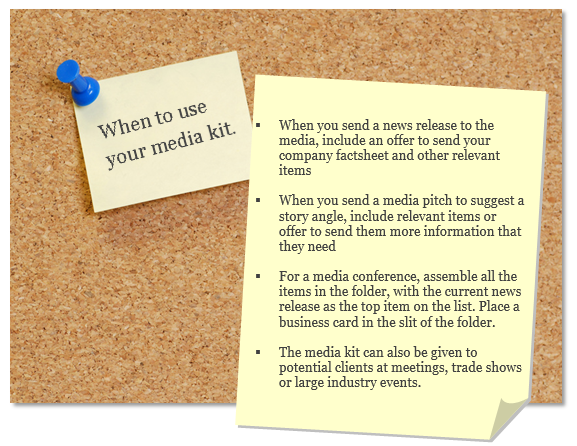
What to prepare for your media kit.
- Media pitch letter or email. This is a personalized message to the reporter that offers a teaser to interest him in reading your news release, or suggests an interesting story angle about your company or product that he can write about. Remember, this angle must be relevant to the reporter and his readers.
- A list of the items in the media kit; not all items are needed for every announcement.
- News release, media statement or speech on your current announcement.
- Company and product factsheets, preferably on company letterhead. Describe your company’s achievements and activities and key products and competencies.
- Key personnel fact sheets, preferably on company letterhead. Prepare one-page biographies of key company personnel, describing their professional experience and achievements with the company. Include photographs if possible.
- Past news releases or news clippings of positive media coverage
- Company newsletter or articles written by your company
- Visuals. Interesting visuals attract attention to your news. Photographs that show an interesting aspect of your business or graphics that explain a difficult concept add to the story and would be appreciated. Provide high resolution photos, images and videos in a CD-rom or DVD, or offer to email upon request.
- Translations make it convenient for the ethnic media to write your story. Provide translations of your company name, names and designations of the spokespersons, and industry or technical terms that may need to be used in the writing of the article.
- Business card of media contact person
- Good quality folders, preferably with your company logo
Step 4:
Get your story to the media. Send your news release or media pitch to the right media.
1. Send it out
Decide which local editors, journalists or freelancers should receive your news release based on your type of news or story. Send only informative and well thought out messages, otherwise you will tarnish your own credibility with the media.
>Paid Distribution
If you would like to distribute to a large range of news media, you may consider using a news release distribution service. The most established distribution services charge for their services and can be quite expensive. For example, PR Newswire (www.prnewswire.com) and Business Wire (www.businesswire.com)
>Free Distribution
Today, businesses need not pay for distribution as there are sites on the Internet that will distribute on your behalf for free. When looking for such a service, simply type “free press release distribution” into your Internet browser. Once you register with these companies, you can upload your news release almost immediately. Many of these services require you to have both header and sub header, so prepare ahead of time.
>Local Media Desks
You can also send your news release directly to the relevant desk of the media you would like to be featured in. Each media may have several desk editors, such as News Desk for stories of general interest, Money Desk for stories relating to business and finance, and there is often
also an editor in charge of SME news. It may be worth your while to find out which day or time is dedicated to SME news so that you can time your news releases, as you may have a better chance of being featured there.
Tip
Separate email address for distribution
Create separate email addresses for each free or paid distribution site that you use. You can then track which site has been more effective in distributing your news release.
Tip
Media Contacts
Visit The Institute of Public Relations of Singapore (IPRS) for a listing of local News Desks. For a complete listing of the media organisations in Singapore, you can refer to the Media Guide on SGPressCentre, the Singapore Government’s media website.
2. Follow up
Once you have sent a news release or media pitch to the media, it is useful to follow up with a phone call. However, you must first prepare yourself.
- You must be able to describe in a few short sentences why your news would be of interest to the reporter’s audience. Practice talking through the story angles before getting on the phone. Get all information, facts and figures ready.
- Call at a good time. For newspaper reporters, try calling during mid-morning till noon. Remember that it is good practice to always ask whether it is a good time to talk now, and if it not, when would be a good time to call back.
- Be prepared to re-send your news by email or fax to the reporter who has been assigned to write the article.
- If the media has accepted your news, keep a look out for your story in that media. The article clippings can be added to your media kit to show third party endorsement for your business.
Tip
Lunches & Gifts
While it is important to establish a good relationship with the media, lunches and gifts are not exactly sought for, unless you are giving them the chance to try a new product or service, which they can then write about. The best way by far is to keep providing them with good story angles and meaty information with which they can write interesting stories.
Step 5:
Hold a media conference. Invite journalists to tell them about your upcoming event, provide them with new information or clarify burning issues.
Also known as a press conference or media briefing, this is useful when the news you are announcing is complex, involves many parties, offers photo opportunities or involves a sensitive issue, and as such is better announced in person, so that there is opportunity for questions and answers.
How to prepare for your media conference
- Send the media an invitation. Like the media pitch letter or email, this could include a teaser to interest the media in your news, then briefly outline what the news is about. Remember to make it relevant to the reporter and his readers. Include the programme outline, keeping to about 1 - 1.5 hours.
- Check with the media desk whether they have decided to cover your story.
- Hold the media conference at a good time. Most press conferences are held in the morning so that journalists have time to file their stories. Avoid competing for attention with other major events involving the news section you are targeting.
- Hold the media conference in a place that is quiet enough for discussion and can hold the expected number of people. There should be sufficient space so that the camera crew and photographers have room to move around for good shots. Ideally this can be on or near your business premises where good photographs or videos can be taken.
- Welcome the media and present them with your media kit. Make sure you know their names and which media they represent so that you can introduce them. Use tent cards with the name of each media as this would help your spokespersons identify them.
- Determine ahead of time who the spokesperson or spokespersons will be. Keep the number of panel members to a minimum. Help them to focus on the key messages by preparing speaking points, with care given to how they should be phrased. Use tent cards with names and designations to help the media identify them.
- Depending on formality, the chairperson or emcee would start the session and manage the programme timing. A 5 - 10 min presentation could be given if it is relevant to the announcement. The spokespersons deliver their media statements, then the reporters are invited to ask questions.
- After the news conference, the reporters may request for interviews with specific individuals. Broadcast reporters would require quieter surroundings so that they can get good recordings. Photography or filming may be required at alternative locations.
- Immediately after the news conference, send the media kit to reporters who were unable to attend but are still interested to cover your story. Offer to provide them with a summary of the key points from the discussion. As usual, keep a look out for your story in the various media.
- Remember to inform your own employees and other key stakeholders about the announcement as well.
Step 6:
Handle the media in a crisis with sincerity, integrity and promptness. It will win you their respect.
If you know bad news is about to break, it is important that you bring it to the media first. When your company breaks the story, you are in control of the message. The goal is to stay ahead of the game. Be aware of any issues that could turn into bad publicity for the company.
How to handle the media in a crisis
- Hold an internal meeting to decide on the issues and the key messages. The company must show unity and commitment to a common purpose.
- Choose a single spokesperson to handle the crisis on behalf of the organization. A familiar face with consistent communication and responses gives assurance that the company is in control of the situation.
- In certain circumstances, for example, an industrial accident, you may need to identify a single communication center to co-ordinate your internal information gathering and decision-making, with a separate media briefing area where media can receive updates or attend news conferences.
- Distribute an initial press release. If there are unknowns, issue holding statements to buy time till you are able to provide information. Let the media know when to expect regular future updates and keep to your word, or the media and the public will start making guesses. Update relevant items in your media kit to support the current situation if necessary.
- Respond to individual calls by the media by sharing the time of your next media briefing, and inviting them to attend. If need be, consult with the company’s attorney before any public comments are made.
- Monitor the media throughout the crisis. If you discover information has been reported incorrectly, take immediate corrective action. Keep a log throughout the crisis of all media reports and contacts, and use these notes to hone future media plans.